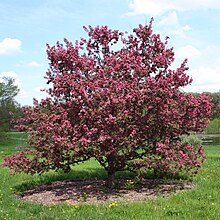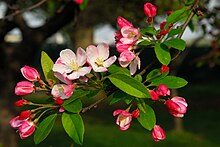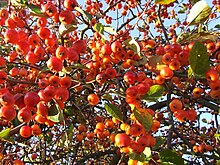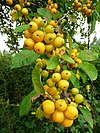Малус
| Малус Временный диапазон:
| |
|---|---|

| |
| Малус «Фиолетовый принц» [ 1 ] | |
| Научная классификация | |
| Королевство: | Plantae |
| Clade: | Tracheophytes |
| Clade: | Angiosperms |
| Clade: | Eudicots |
| Clade: | Rosids |
| Order: | Rosales |
| Family: | Rosaceae |
| Subfamily: | Amygdaloideae |
| Tribe: | Maleae |
| Subtribe: | Malinae |
| Genus: | Malus Mill. |
| Type species | |
| Malus sylvestris Mill. (1768)
| |
| Species | |
|
See text | |
| Synonyms[2] | |
| |
Малус ( / M Eɪ L S s/ [ 3 ] или / ˈ M æ L ə s / ) - это род из примерно 32–57 видов [ 4 ] из небольших лиственных деревьев или кустарников в семье розасей , в том числе одомашненное яблоко фруктового сада , крабовые яблоки (иногда известные в Северной Америке как «крабовые») и дикие яблоки .
Род родной для умеренной зоны северного полушария .
Описание
[ редактировать ]
Apple trees are typically 4–12 metres (13–39 feet) talI at maturity, with a dense, twiggy crown. The leaves are 3–10 сантиметров ( 1 + 1 ⁄ 4–4 дюйма) длиной, альтернативная, простая, с зубчатым краем. Цветы пыльцу носят в Corymbs и имеют пять лепестков , которые могут быть белыми, розовыми или красными, и идеальны , обычно с красными тычинками, которые производят обильную , и полупринятым яичником ; Цветение происходит весной после 50–80 дней растущей степени (в значительной степени варьируется в зависимости от подвида и сорта ). [ Цитация необходима ]
Many apples require cross-pollination between individuals by insects (typically bees, which freely visit the flowers for both nectar and pollen); these are called self-sterile, so self-pollination is impossible, making pollinating insects essential.[5]
A number of cultivars are self-pollinating, such as 'Granny Smith' and 'Golden Delicious', but are considerably fewer in number compared to their cross-pollination dependent counterparts.[citation needed]
Several Malus species, including domestic apples, hybridize freely.[6]
The fruit is a globose pome, varying in size from 1–4 cm (1⁄2–1+1⁄2 in) in diameter in most of the wild species, to 6 cm (2+1⁄4 in) in M. sylvestris sieversii, 8 cm (3 in) in M. domestica, and even larger in certain cultivated orchard apples. The centre of the fruit contains five carpels arranged star-like, each containing one or two seeds.[citation needed]
Subdivisions and species
[edit]36 species and 4 hybrids are accepted.[2] The genus Malus is subdivided into eight sections (six, with two added in 2006 and 2008).[citation needed] The oldest fossils of the genus date to the Eocene (Lutetian), which are leaves belonging to the species Malus collardii and Malus kingiensis from western North America (Idaho) and the Russian Far East (Kamchatka), respectively.[7]
Species
[edit]36 species and four natural hybrids are accepted:[2]
- Malus angustifolia (Aiton) Michx. – southern crabapple
- Malus asiatica Nakai – Chinese pearleaf crabapple
- Malus baccata (L.) Borkh. – Siberian crabapple
- Malus brevipes – shrub apple
- Malus coronaria (L.) Mill. – sweet crabapple
- Malus crescimannoi Raimondo
- Malus daochengensis C.L.Li
- Malus domestica (Suckow) Borkh. – domestic or orchard apple
- Malus doumeri (Bois) A.Chev. – Taiwan crabapple
- Malus florentina (Zuccagni) C.K.Schneid. – Florentine crabapple, hawthorn-leaf crabapple
- Malus fusca (Raf.) C.K.Schneid. – Oregon or Pacific crabapple
- Malus halliana Koehne – Hall crabapple
- Malus honanensis Rehder
- Malus hupehensis (Pamp.) Rehder – tea crabapple
- Malus ioensis (Alph.Wood) Britton – prairie crabapple
- Malus jinxianensis J.Q.Deng & J.Y.Hong
- Malus kansuensis (Batalin) C.K.Schneid. – Calva crabapple
- Malus komarovii (Sarg.) Rehder
- Malus leiocalyca S.Z.Huang
- Malus mandshurica (Maxim.) Kom. ex Skvortsov
- Malus muliensis T.C.Ku
- Malus niedzwetzkyana – Niedzwetzky's Apple
- Malus ombrophila Hand.-Mazz.
- Malus orientalis Uglitzk.
- Malus prattii (Hemsl.) C.K.Schneid. – Pratt's crabapple
- Malus prunifolia (Willd.) Borkh. – plum-leaf crabapple, Chinese crabapple
- Malus rockii Rehder – native to China and Bhutan
- Malus sikkimensis (Wenz.) Koehne – Sikkim crabapple
- Malus spectabilis (Aiton) Borkh. – Asiatic apple, Chinese crabapple
- Malus spontanea (Makino) Makino - nokaidō
- Malus sylvestris (L.) Mill. – European crabapple
- Malus toringo (Siebold) de Vriese (syns. Malus sargentii, Malus sieboldii) – Sargent crabapple, Toringo crabapple, or Siebold's crabapple
- Malus toringoides (Rehder) Hughes – cut-leaf crabapple
- Malus transitoria (Batalin) C.K.Schneid. – cut-leaf crabapple
- Malus trilobata (Labill. ex Poir.) C.K.Schneid. – Lebanese wild apple, erect crabapple, or three-lobed apple tree
- Malus turkmenorum Juz. & Popov (syn. Malus sieversii) – wild ancestor of cultivated species Malus domestica
- Malus yunnanensis (Franch.) C.K.Schneid. – Yunnan crabapple
- Malus zhaojiaoensis N.G.Jiang
- Hybrids
- Malus × floribunda Siebold ex Van Houtte – Japanese flowering crabapple
- Malus × kaido (Wenz.) Pardé (syn. Malus × micromalus) – midget crabapple
- Malus × soulardii (L.H.Bailey) Britton
- Malus × zumi (Matsum.) Rehder
Formerly placed here
[edit]- Macromeles tschonoskii (Maxim.) Koidz. (as Malus tschonoskii (Maxim.) C.K.Schneid.) – Chonosuki crabapple and pillar apple[citation needed]
Selected artificial hybrids
[edit]- Malus × sublobata – yellow autumn crabapple (M. asiatica × M. toringo)
Fossil species
[edit]After[7]
- Malus collardii Axelrod, North America (Idaho), Eocene
- Malus kingiensis Budants, Kamchatka Peninsula, Russia, Eocene
- Malus florissantensis (Cockerell) MacGinitie Green River Formation, North America (Colorado) Eocene
- Malus pseudocredneria (Cockerell) MacGinitie Green River Formation, North America (Colorado) Eocene
- Malus idahoensis R.W.Br. North America (Idaho), Miocene
- Malus parahupehensis J.Hsu and R.W.Chaney Shanwang, Shandong, China, Miocene
- Malus antiqua Doweld Romania, Pliocene
- Malus pseudoangustifolia E.W.Berry North America (South Carolina), Pleistocene
Cultivation
[edit]

Crabapples are popular as compact ornamental trees, providing blossom in spring and colourful fruit in autumn. The fruits often persist throughout winter. Numerous hybrid cultivars have been selected.[citation needed]
Some crabapples are used as rootstocks for domestic apples to add beneficial characteristics.[8] For example, the rootstocks of Malus baccata varieties are used to give additional cold hardiness to the combined plants for orchards in cold northern areas.[9]
They are also used as pollinizers in apple orchards. Varieties of crabapple are selected to bloom contemporaneously with the apple variety in an orchard planting, and the crabs are planted every sixth or seventh tree, or limbs of a crab tree are grafted onto some of the apple trees. In emergencies, a bucket or drum bouquet of crabapple flowering branches is placed near the beehives as orchard pollenizers.[citation needed]
Because of the plentiful blossoms and small fruit, crabapples are popular for use in bonsai culture.[10][11][12]
Cultivars
[edit]These cultivars have won the Royal Horticultural Society's Award of Garden Merit:-[13]
Other varieties are dealt with under their species names.
Toxicity
[edit]The seeds contain cyanide compounds.[22]
Uses
[edit]Crabapple fruit is not an important crop in most areas, being extremely sour due to malic acid (which like the genus derives from the Latin name mālum), and in some species woody, so is rarely eaten raw. In some Southeast Asian cultures, they are valued as a sour condiment, sometimes eaten with salt and chilli or shrimp paste.[citation needed]
Some crabapple varieties are an exception to the reputation of being sour, and can be very sweet, such as the 'Chestnut' cultivar.[23]
Crabapples are an excellent source of pectin. Using sugar and spices such as ginger, nutmeg, cinnamon, and allspice, their juice can be made into ruby-coloured crab apple jelly with a full, spicy flavour.[24] A small percentage of crabapples in cider makes a more interesting flavour.[25] As Old English Wergulu, the crab apple is one of the nine plants invoked in the pagan Anglo-Saxon Nine Herbs Charm, recorded in the 10th century.
Applewood gives off a pleasant scent when burned, and smoke from an applewood fire gives an excellent flavour to smoked foods.[26] It is easier to cut when green; dry applewood is exceedingly difficult to carve by hand.[26] It is a good wood for cooking fires because it burns hot and slow, without producing much flame.[26] Applewood is used to make handles of hand saws; in the early 1900s 2,000,000 board feet of applewood were used annually for this purpose.[27]
Gallery
[edit]-
Apple blossom. Eastern Siberia
-
Ripe wild crab apples (Malus sylvestris)
-
Baskets of crab apples for sale in Connecticut in 1939
-
Trunk
References
[edit]- ^ Cirrus Digital Purple Prince Crabapple
- ^ Jump up to: a b c "Malus Mill". Plants of the World Online. Royal Botanic Gardens, Kew. Retrieved 17 December 2023.
- ^ Sunset Western Garden Book, 1995:606–607
- ^ Phipps, James B.; Robertson, Kenneth R.; Smith, Paul G.; Rohrer, Joseph R. (1990). "A checklist of the subfamily Maloideae (Rosaceae)". Can. J. Bot. 68 (10): 2209–2269. doi:10.1139/b90-288.
- ^ coreyrametta (2019-06-11). "Are Apple Trees Self Pollinating?". Cold Hardy Fruits. Retrieved 2024-05-02.
- ^ Ken Wilson and D.C. Elfving. "Crabapple Pollenizers for Apples". Ontario Ministry of Agriculture and Food. Retrieved 12 Sep 2013.
- ^ Jump up to: a b Liu, Bin-Bin; Ren, Chen; Kwak, Myounghai; Hodel, Richard G.J.; Xu, Chao; He, Jian; Zhou, Wen-Bin; Huang, Chien-Hsun; Ma, Hong; Qian, Guan-Ze; Hong, De-Yuan; Wen, Jun (May 2022). "Phylogenomic conflict analyses in the apple genus Malus s.l. reveal widespread hybridization and allopolyploidy driving diversification, with insights into the complex biogeographic history in the Northern Hemisphere". Journal of Integrative Plant Biology. 64 (5): 1020–1043. doi:10.1111/jipb.13246. ISSN 1672-9072. PMID 35274452. S2CID 247384781.
- ^ Apple Tree Rootstocks Ecogardening Factsheet #21, Summer 1999
- ^ Alaska Department of Natural Resources [https://web.archive.org/web/20080719050542/http://www.dnr.state.ak.us/ag/21Applerootstocks.pdf Archived 2008-07-19 at the Wayback Machine
- ^ Biel, John. "Collecting and Training Crab Apples | American Bonsai Society". www.absbonsai.org. American Bonsai Society. Archived from the original on 3 July 2016. Retrieved 2 August 2016.
- ^ "Crabapple (Malus) - Bonsai Empire". www.bonsaiempire.com. Retrieved 2 August 2016.
- ^ Walston, Brent. "Crabapples for Bonsai". evergreengardenworks.com. Retrieved 2 August 2016.
- ^ "AGM Plants - Ornamental" (PDF). Royal Horticultural Society. July 2017. p. 63. Retrieved 2 April 2018.
- ^ "RHS Plantfinder - Malus 'Adirondack'". Retrieved 25 March 2018.
- ^ "RHS Plantfinder - Malus 'Butterball'". Retrieved 25 March 2018.
- ^ "Malus 'Comtesse de Paris'". RHS. Retrieved 6 January 2021.
- ^ "RHS Plantfinder -Malus 'Evereste'". Retrieved 25 March 2018.
- ^ "RHS Plantfinder - Malus Jelly King = 'Mattfru'". Retrieved 25 March 2018.
- ^ "RHS Plantfinder - Malus 'Laura'". Retrieved 25 March 2018.
- ^ "RHS Plantfinder - Malus × robusta 'Red Sentinel'". Retrieved 25 March 2018.
- ^ "RHS Plantfinder - Malus 'Sun Rival'". Retrieved 25 March 2018.
- ^ The Complete Guide to Edible Wild Plants. United States Department of the Army. New York: Skyhorse Publishing. 2009. p. 113. ISBN 978-1-60239-692-0. OCLC 277203364.
{{cite book}}: CS1 maint: others (link) - ^ "The Growing Guide". Stark Bro's Nurseries & Orchards Co. Archived from the original on 2014-07-26.
- ^ Rombauer, I.; Becker, M. R.; Becker, E. (2002) [2002]. All About Canning & Preserving (The Joy of Cooking series). New York: Scribner. p. 72. ISBN 0-7432-1502-8.
- ^ "The Science of Cidermaking". Andrew Lea. Retrieved November 14, 2013.
- ^ Jump up to: a b c Fraser, Anna (22 August 2005). "Properties of different trees as firewood". Retrieved 17 July 2008.
- ^ Burks, Jeff (2015). "Woods Used in Saw Handles". Lost Art Press, Traditional Hand-tool Skills. blog.lostartpress.com.
External links
[edit]- Germplasm Resources Information Network: Malus
- Flora of China: Malus
- Virginia Cooperative Extension - Disease resistant crabapples Archived 8 February 2007 at the Wayback Machine
- Программа PRI, устойчивая к разведению яблок : кооператив среди Университета Пердью , Университет Рутгерса и Университета Иллинойса .




